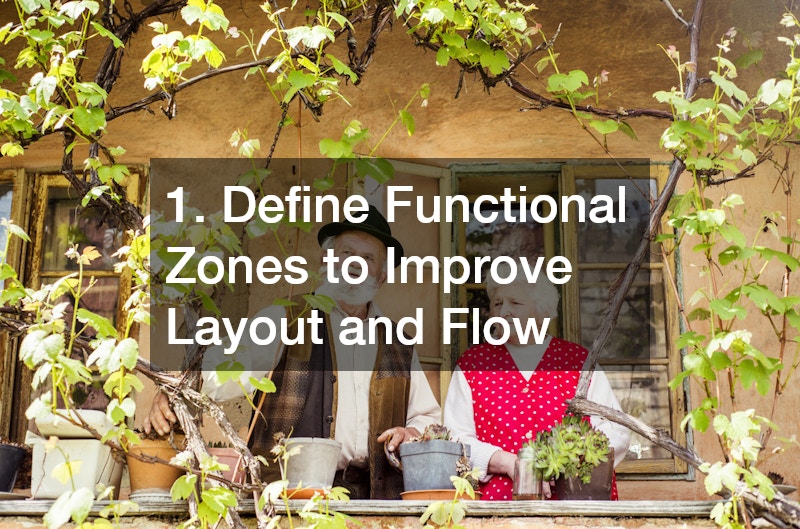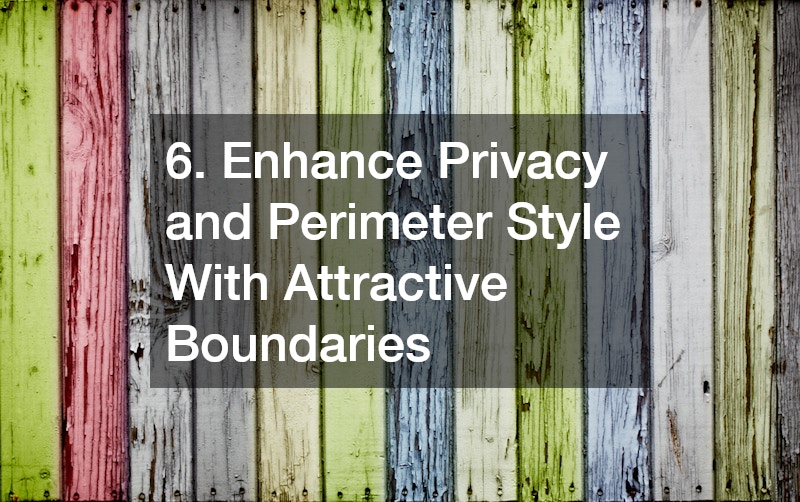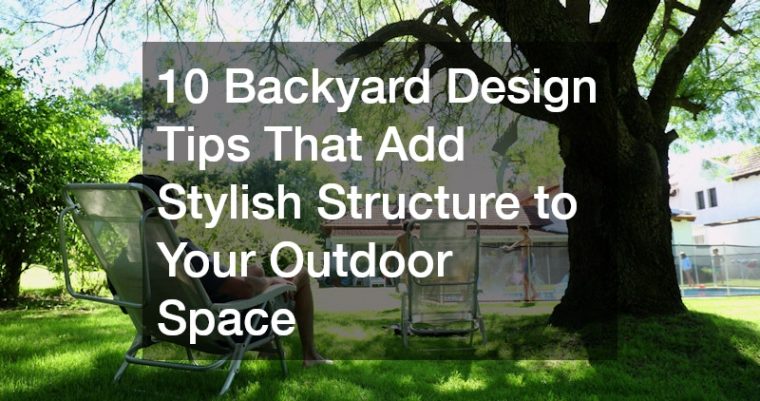
Creating a backyard that feels intentional, modern and beautifully organised doesn’t require a complete renovation. With the right combination of design features, layout improvements and functional upgrades, you can transform an ordinary yard into a cohesive outdoor living space that’s attractive year-round. The key is understanding how individual elements—both visual and structural—contribute to a sense of flow, balance and purpose. These ideas help homeowners maximise the space they already have while improving comfort, usability and visual appeal. Whether your goal is relaxation, entertaining, or simply giving your yard a cleaner, more polished look, the following design tips will make a noticeable difference.
1. Define Functional Zones to Improve Layout and Flow

Creating distinct zones is one of the most effective ways to bring structure to any outdoor environment. When a yard has clear areas for dining, lounging, gardening and recreation, it automatically looks more organised. Consider how you want to use the space, then determine the most natural location for each activity. Aligning these zones with existing shade patterns, pedestrian paths and sight lines ensures they feel intuitive rather than cramped or scattered.
One way homeowners maintain healthier plant beds and reduce manual watering is by installing an irrigation system. An irrigation system can be integrated into garden zones without disrupting the overall design, and it supports consistent plant growth over time.
Paths or low borders create subtle boundaries that guide movement while enhancing the visual flow. You can use furniture arrangements, lighting placement or even changes in ground material to indicate transitions from one area to the next without interrupting the openness of the landscape.
2. Use Strategic Hardscaping to Shape the Space
Hardscaping is essential for giving a backyard its bones. Thoughtfully placed stones, pathways, borders and platforms create durable, high-impact visual structure. These surfaces help guide traffic flow, support outdoor furniture and make the entire yard easier to maintain. Hardscaping also defines how people interact with the space, encouraging movement from one area to another.
Many homeowners enhance the usability of their yard by scheduling landscape paver installation. Landscape paver installation adds stability and visual rhythm to walkways, patios and entertainment spaces, creating a modern and long-lasting foundation for outdoor living.
When selecting materials, consider colour tone, surface finish and environmental compatibility. Natural stone creates an organic feel, while concrete or manufactured pavers offer a cleaner, more contemporary look. Combining textures—such as pairing smooth pavers with rough stone—adds subtle complexity without overwhelming the layout.
Durable materials help maintain backyard structure through all seasons. They resist erosion, create smooth walking surfaces and reduce mud or debris from entering indoor areas. Raised platforms or built-in seating also enhance organisation and offer convenient zones for social gatherings.
Thoughtful placement of hardscaping elements ensures a natural sense of movement throughout the yard. Visual anchors, such as large stepping stones or patterned paths, help unify various features across the property.
3. Introduce Vertical Elements for Height and Balance

Backyards often feel flat when all design elements sit at ground level. Vertical features create balance, pull the eye upward and give the space more presence. Trellises, pergolas, tall plantings and privacy screens contribute visual depth and help define different areas of the yard while maintaining an airy feel.
One way homeowners protect their yards from unwanted insects is by investing in regular pest control. Pest control services keep outdoor structures comfortable and enjoyable so vertical garden features and architectural elements remain functional throughout every season.
Tall features also soften fence lines and create transitions between hardscaping and softer planting areas. Consider placing columnar shrubs or small trees to frame an entrance or line a walkway. These transitions guide movement and create inviting visual cues.
Pergolas and arbors add sophistication, especially when paired with climbing plants. They also work well as shade structures for outdoor seating, helping anchor a lounging or dining area. Even simple vertical features, like decorative screens, shift the perception of space and make a backyard feel more layered and intentional.
Using height strategically helps distribute visual weight across the yard. This prevents design elements from feeling crowded at the edges and keeps the centre of the yard from appearing empty or unbalanced.
4. Add Natural Focal Points With Trees and Large Plantings
Trees are powerful design elements. They add shade, texture, colour and rhythm to any backyard layout. A thoughtfully placed tree can frame a view, anchor a seating area or create a sense of enclosure. Larger shrubs and ornamental trees can also function as living walls that visually divide the yard without the heaviness of built structures.
Many homeowners maintain the long-term health and aesthetics of their property with a trusted tree service. A tree service can shape growth patterns, manage overgrowth and ensure that large plantings enhance rather than overwhelm the space.
Using trees to create symmetry helps strengthen the overall design. Planting matching varieties on either side of a walkway or patio establishes balance and draws the eye toward focal features. Even a single well-chosen tree can add elegance when planted in a strategic spot such as a corner or near a seating area.
Shade trees also cool the space and make outdoor areas more inviting. They support layered landscaping by creating canopy levels above shrubs and groundcover. Their presence naturally divides zones while maintaining a connected flow throughout the yard.
Selecting varieties suited to your climate ensures long-term performance. Native species typically require less maintenance and offer seasonal interest with minimal upkeep.
5. Build Terraced or Reinforced Areas for Elevation Changes
Working with elevation is an excellent way to introduce visual variation and structure. Terraces, berms and reinforced slopes help manage uneven terrain while offering opportunities for creative planting and attractive structural features. These raised or lowered platforms break up large open spaces and allow for more dynamic design.
For homeowners looking to create stable, sculpted spaces, rock retaining walls are a popular solution. Rock retaining walls help reinforce slopes, prevent erosion and add rugged visual contrast that’s both functional and decorative.
Layered terraces allow you to dedicate each level to a specific purpose—such as seating, planting or storage—while ensuring stability. These platforms create natural focal points and give the yard a terraced garden look often found in high-end outdoor landscapes.
When working with elevation, it’s important to maintain smooth transitions between levels. Steps, ramps or tiered pathways help connect the spaces while providing safe access. Integrating lighting along these transitions also improves evening usability.
Adding raised areas not only expands the visual interest of the yard but also increases functionality. Elevated dining platforms, raised gardens and multi-level lounging areas enhance the richness of the environment and encourage more diverse uses of the outdoor space.
6. Enhance Privacy and Perimeter Style With Attractive Boundaries

Backyard privacy plays a major role in creating a comfortable environment. Boundaries such as fences, hedges and privacy screens frame the space while giving homeowners a sense of enclosure. When thoughtfully designed, these boundaries also contribute significant visual structure by defining the limits of the yard and supporting the overall layout.
Many homeowners upgrade their property lines with a redwood fence. A redwood fence blends durability with a warm, natural aesthetic that complements both modern and traditional landscapes.
Solid boundaries can be softened with greenery, climbing plants or decorative accents. Mixing height levels and textures also keeps the perimeter visually appealing without creating a walled-in feel. In smaller yards, partial privacy screens or alternating materials help maintain openness.
Adding lighting along the boundary further enhances evening ambiance and highlights architectural details. When the yard is viewed as a cohesive whole, the perimeter plays a quiet but powerful role in shaping its appearance.
Well-designed boundaries create a sense of safety, intimacy and separation from neighbouring properties. They also help frame garden features and anchor seating areas.
7. Improve Entertainment Areas With Purpose-Built Features
Backyards serve as extensions of the home, making outdoor entertainment spaces increasingly important. Creating dedicated gathering zones enhances comfort, flow and structure. Whether your yard includes a large patio or a small deck, the goal is to create areas that feel welcoming and intentionally organised.
Homeowners who enjoy water features often rely on professional pool repair services. Pool repair keeps swimming areas safe, functional and visually consistent with surrounding entertainment zones, ensuring the space remains a reliable centrepiece.
Thoughtfully arranged seating promotes conversation and natural movement. Incorporating built-in benches, outdoor furniture groupings or modular seating arrangements helps structure the space without clutter. Adding durable surfaces and weather-friendly materials also improves longevity.
For added interest, consider integrating dining areas, sun lounges or outdoor bars. These features create natural transitions between zones and encourage regular use. Lighting, shade structures and textile accents make the area even more inviting.
Clear boundaries—such as planters, steps or subtle elevation changes—help separate entertainment spaces from garden areas while maintaining flow throughout the yard.
8. Add Warmth and Ambience With Architectural Fire Features

Fire features extend the usability of outdoor spaces into the evening and cooler seasons. They provide warmth, create a natural gathering area and add a striking focal point to the backyard. When integrated thoughtfully, they enhance the architectural structure of the yard and complement existing design elements.
Homeowners who want a built-in element with lasting impact often consider outdoor fireplaces. Outdoor fireplaces add both function and visual weight, becoming a central feature that ties seating and social areas together.
Placement is key. A fire feature should be situated where it can be enjoyed from multiple angles without interrupting natural circulation patterns. It can anchor a seating arrangement or highlight the end of a pathway.
Materials play an important role in the aesthetic. Stone, brick and concrete create a strong architectural presence. Pairing these materials with surrounding hardscaping ensures cohesion and helps the fire feature feel like a natural extension of the home.
Lighting, comfortable seating and complementary décor materials complete the space. These features make the area more inviting and support year-round enjoyment.
9. Integrate Custom Surfaces and Decorative Paths
Decorative pathways and custom surfaces contribute both structure and style. They guide movement, highlight focal points and break up large open areas. Paths can connect garden zones, entertainment areas and lounging spaces while serving as a subtle landscape design tool.
Many property owners rely on a skilled paving contractor to create custom pathways. A paving contractor ensures precision, durability and aesthetic consistency, making the finished surfaces both attractive and long-lasting.
Curved paths add softness to rigid layouts, while straight lines create a more modern, clean effect. Material combinations—such as gravel borders with stone centres—add depth and visual contrast. These design choices help reinforce the structure of the yard.
Pathways also create opportunities for accent lighting, which enhances safety and contributes to nighttime ambiance. Combined with planting borders or small architectural elements, paths can unify the entire backyard layout.
Well-planned surfaces play an important role in dividing sections of the yard while maintaining an overall cohesive aesthetic.
10. Expand Living Space With Covered or Enclosed Outdoor Rooms
Covered patios, garden rooms and sheltered structures give backyards year-round usability. They create a sense of enclosure and comfort while still maintaining a connection to the outdoors. These spaces provide architectural structure and extend the home’s footprint. Some homeowners personalise their outdoor living area with an enclosed screened porch. An enclosed screened porch offers comfort, insect protection and shaded relaxation, enhancing the usability of the yard during all seasons.
Covered areas frame views toward the garden and set visual boundaries that help organise the outdoor layout. They create a natural hub for gatherings and offer shade and shelter during different types of weather. Adding features such as built-in seating, overhead lighting or outdoor-rated rugs further enhances comfort. These design decisions support long-term enjoyment while reinforcing the structure of the yard.
